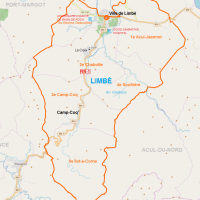Limbe

The chief city of Limbé Arrondissement, it is a municipality inhabited by 32,200 inhabitants as per 2003 census. After Cap-Haïtien it is the second most important city in the Northern Department. Bas-Limbé and Limbé are the two communes which include other seven rural sections. It is located to the north of Haiti’s capital, Port-au-Prince by a distance of 220 km. Acul-du-Nord, Bas-Limbé, Cap-Haïtien, Port-Margot and Plaisance are the neighboring cities and towns to access from Limbé.
One of the eighteen communes of the Northern Department, Limbé did not have an old name. Its date of elevation to the rank of commune is not specified. It has a district and six communal sections. The commune of Limbé is interior, its dominant relief is the plain and its climate varies from the normal to the extremes. Its inhabitants bear the name of Limbéan. In 1998, the population of the commune of Limbé was 45 858 inhabitants. In 2004, the projection placed this number at a little over 48,000 inhabitants. The center of town measures about a square mile (2.74 km2) and has a density of 51,590 per square mile. (19,770 inhabitants / km2).
Limbé city derives its strength and a base of diverse agriculture from the Limbé River. Near the sea in Bas-Limber, rice is produced and in the city’s surrounding areas, mango, coffee, banana and fruits of other kinds are produced.
Regarding the Economic and Financial Establishments, a dozen restaurants, varying according to their size, a bank, a credit union and a marketing cooperative provide services to the municipality of Limbé.
The city of Limbé was built at the edge of the Limbé River. Its uniqueness is matched by the valley of the river Limbe, which is still green and lush, in contrast to a region dealing with deforestation issues.
General and advanced deforestation is carried out in large scale at Limbé which has diminished the river’s flow, presently. However as compared to the rest of Haiti, Limbé still continues to have trees in large numbers.
Education: The Ministry of National Education of Youth and Sports is represented in the commune by a school inspection office. The school district has several primary schools and secondary schools, along with two vocational schools, eleven literacy centers and a university.
A private and non-profit autonomous institution called Université Chrétienne du Nord d’Haïti provides higher education. The UCNH provides educational services such as teaching and research.
Health: In terms of health, the municipality has no representation from the Ministry of Public Health and Population. However, five clinics and a hospital were inventoried. The medical staff is composed of doctors, dentists, nurses, auxiliaries, a certified matron and laboratory technician for more than 45,000 inhabitants.
The town has a hospital called “Good Samaritan” that works and research to fight against malaria. “Hôpital Bon-Samaritain” and Dispensaire St-Jean are the two well-functioning facilities in Limbé. A lot of people flock to the hospitals due to easy accessibility of services in health care.
Utilities: The commune of Limbe is well supplied with water, it has 13 rivers, 17 sources, a pond, three lagoons, single boreholes, artesian wells and public fountains.
To power the city an electrical dam was built by Dr.Hodges around 1973. In 1976, people got running water at their homes and public fountains. However, the dam is not active any longer. Only the city of Limbe is electrified by means of an electric motor. The power frequency is 27 hours / week.
Limbé is flood prone. The major flash flood on November 18, 1963, caused the hurricane Flora. Estimates state that around 100 to 500 people lost their lives. The raging water washed away and damaged a large number of houses.
Religion: More than 75 churches (Chapels and temples included) have been inventoried in the municipality of Limbe. Adventist churches (28) are predominant, followed by Baptist churches (23 in total).
Organizations: Two representations of political parties, three popular organizations, three peasants groups, two women’s groups and one NGO were counted in the municipality of Limbe.
Communication: The municipality has functional telephone lines. The postal office does not exist in the Commune of Limbe. The Limbeans are obliged to go to Cap-Haitien to send their mail to the outside or they use the 4VEH radio especially for sending messages to relatives and friends in the various communes of the country. There is no TV station, however, the municipality has a radio station Jupiter located at Haut Levé (National Road) and a newspaper, “la Compass”.
Leisure: As for Culture and Leisure, the town of Limbe does not have a library, but it has a museum. The parish hall serves as a theater room. Football (soccer), volleyball and basketball are the sports practiced in the municipality. There are grounds, certainly, for different sports, but they are not in good condition. In addition, there are eight gagueres and a public square.
Monuments and sites
Le Musée de Guahaba An archeologist founded the Museum of Guahaba, dedicated to the native artifacts of the Ameridian from the Taino and Arawak tribes. The Amerindians called this place Guahaba before it took the name of Limbé.
Fort Dahomey (or Fort Romain, or Fort Crête-Rouge) is one of about twenty military structures built on the territory of Haiti after independence in 1804: this defensive system was directed against a possible return of the French, former masters of the colony of Santo Domingo. The ruins of the fort are located in the communal section of Camp-Coq.

